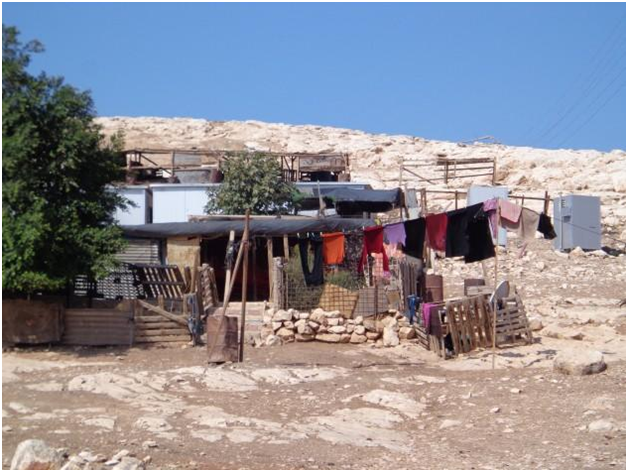AND NOW ISRAEL PLANS TO EXPEL BEDOUINS FROM WEST BANK
Makeshift Bedouin home in a camp east of Jerusalem on the way to Jericho. Credit: Mel Frykberg/IPS

RAMALLAH (IPS): Thirty-year-old Naifa Youssef and 50 other members of her Bedouin community live a precarious life, eking out a hand-to-mouth existence alongside the main road which links Jerusalem with the Dead Sea and the ancient city of Jericho.
Home for this community, east of Jerusalem, comprises a collection of shanty structures and hovels as well as tents erected on the rugged and rocky hills which line the road.
These makeshift homes are not connected to the electricity grid or to water and waste infrastructure. In winter the bitter cold rain and howling winds creep into the structures while mud and sewerage build up in pools around the tents.
Water has to be purchased and brought in by hand from the nearest village of Anata, a 15-minute and 5-km taxi journey away costing about two dollars per person.
Youssef’s community lives below the poverty line as the men folk struggle to make ends meet from casual day labour and herding their goats and sheep, with the area they can graze on limited by Israeli settlements.
The community has lived there for 50 years following their expulsion from the Negev Desert in 1948 when the Israeli state was established. The majority of the West Bank’s Bedouin communities were expelled from the Negev Desert during the same year.
Over the next few years, Israel plans to forcibly expel and relocate approximately 27,000 Palestinian Bedouins from Area C of the West Bank to make way for Israeli settlements.
This followed an announcement by the Israeli government in August that it planned to confiscate over 1,000 acres of West Bank land – the biggest land grab by the Jewish state in three decades.
The West Bank is divided into Area A, under nominal Palestinian control, Area B under joint Israeli-Palestinian control, and Area C (which comprises approximately 60 percent of the territory) under full Israeli control, although overall control of the entire West Bank ultimately falls under Israeli control.
The Israelis argue that under the 1993 Oslo Accords, Area C does not belong to the Palestinians and that most of the structures built there were constructed without permits.
However, obtaining the requisite Israeli building permits for Palestinians is notoriously difficult in East Jerusalem and most parts of the West Bank, and almost impossible in Area C. Critics argue that this is a deliberate policy by the Israeli authorities to keep the occupied territory part of Israel.
The Israeli authorities have warned the Youssefs and their neighbours that they have less than two months to evacuate and that if they refuse to leave they will be forcibly expelled by Israeli security forces.
“We have nowhere else to go, we’ve lived here for many years and have no other land. We also can’t afford to move into a Palestinian village because we can’t afford the rent,” Youssef said.
Youssef’s problems have been experienced by thousands of other Bedouins and will be experienced by thousands more once again as Israel moves to keep most of the West Bank free of Palestinians and exclusively for Israeli settlers and settlements.
In preparation for what some have labelled an accelerated wave of ethnic cleansing, officials from Israel’s Civil Administration, which administers the West Bank, have been demolishing Palestinian infrastructure in Area C including shacks, tents, animal shelters and homes and other structures deemed to have been built “illegally”.
As part of the forced relocation, more than 12,000 Bedouins will be relocated to a new settlement near the West Bank city of Jericho where they will be surrounded by a firing zone, settlements and an Israeli checkpoint which will limit their ability to graze their herds, the main source of income for these nomadic pastoralists.
Several Bedouin communities were forcibly relocated in the 1990s by the Civil Administration from near East Jerusalem to an area of land near a garbage dump in Abu Dis which falls in Area B.
The expulsion of the Bedouins in the 1990s was primarily to make way for enlarging the Israeli settlement of Maale Adumim, one of the largest in the West Bank.
Further to enlarging Maale Adumim, part of Israel’s plan has been to keep an area known as the E1 corridor, which links the settlement with East Jerusalem, contiguous and under Israeli control by building more settlements, effectively dividing the West Bank in two.
The move also further isolates East Jerusalem from the West Bank. East Jerusalem is of great importance to Palestinians due to cultural, educational, family, business, and religious ties. Palestinians also hope to establish a Palestinian state with East Jerusalem as its capital.
“The Civil Administration’s plan blatantly contravenes international humanitarian law, which prohibits the forced transfer of protected persons, such as these Bedouin communities, unless the move is temporary or is necessary for their safety or to meet a military need,” says Israeli rights group B’tselem.
“The Civil Administration’s expulsion plan meets none of these conditions. Israel, as the occupying power, is obligated to act for the benefit and welfare of residents of the occupied territory. Expansion of the settlements does not comport with this requirement.”
(INTER PRESS SERVICE)


